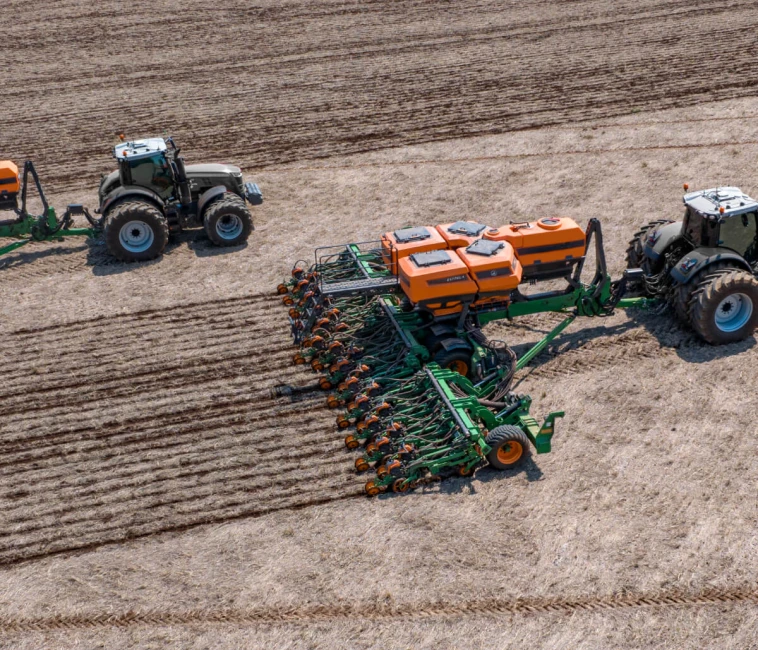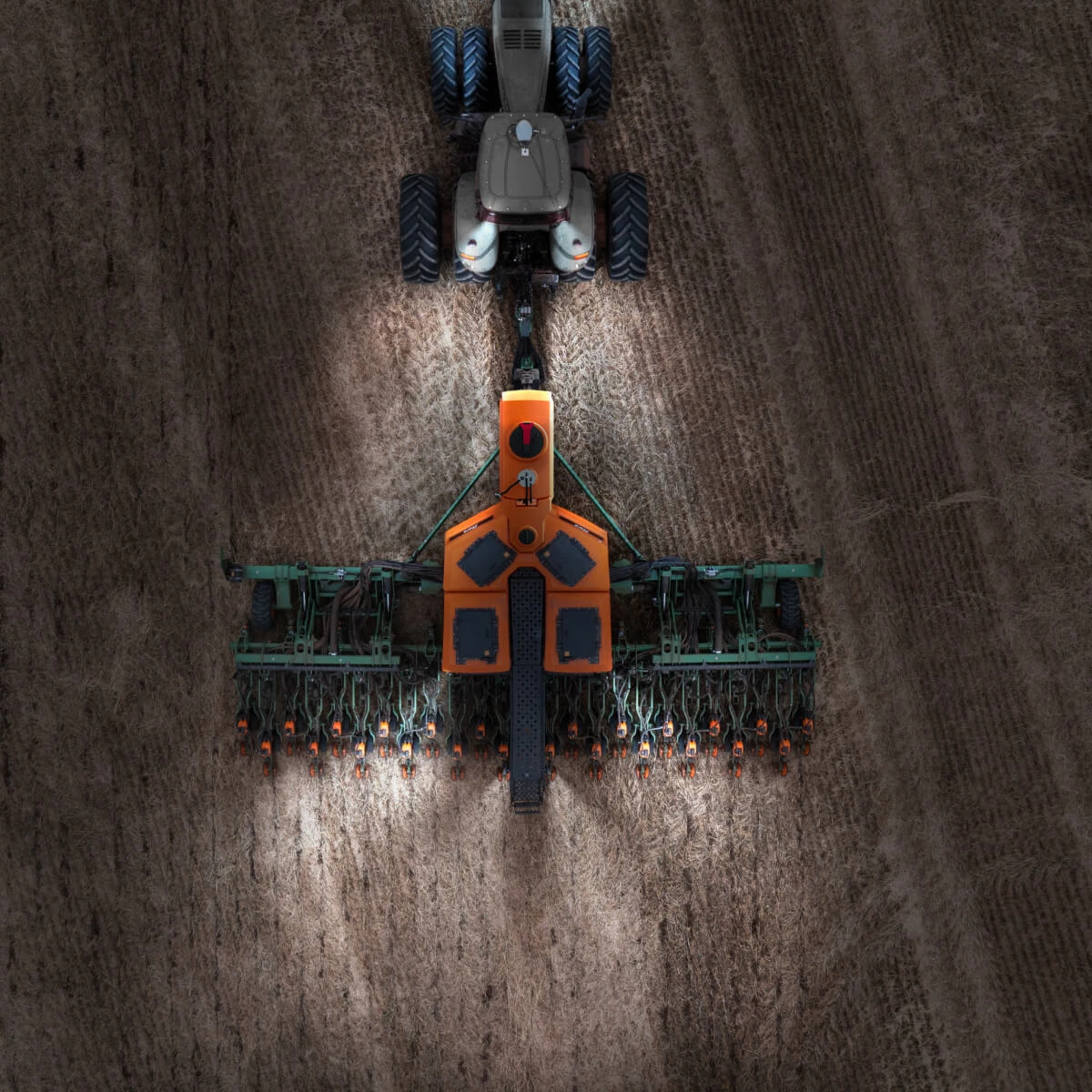For soybeans planting, minor offset can cause huge differences in the result of the crop field. Details such as the straw cutting quality, the correct opening of the furrow, and the precise placement of the seeds are directly connected to the assembly of discs and to the planter adjustment.
When these elements are not taken seriously, the effect is seen in seed bed failures, competition between plants, and even lower production potential.
On the other hand, when the operator allies technical knowledge to the correct adjustment, every seed is placed with more uniformity and the seed bed is developed with balance.
This is where the technology makes the difference: modern systems make the process more predictable, agile, and precise, minimizing waste and boosting the soybeans crop field yield.
The role of each disc for soybeans planting
Every disc has a specific function in the sowing process. From the moment the straw is cut to the final placement of the seed in the furrow, every part contributes for the seed bed uniformity and planting efficiency.
Understanding this role helps the operator to perform more assertive adjustments, choose the correct components, and avoid yield losses.
Cutting discs: first interaction with straw
During the no-till farming process, the cutting discs clean the path for sowing. The adjustment of the spring pressure according to the straw volume is essential to avoid blockage.
Double discs (furrow openers): furrow opening and stability
They open the furrow according to the depth adjusted, make sure the seeds are well positioned. Stable furrow = uniform seed emergence.
Meter discs: correct seed population.
In mechanical systems, choosing the compatible holes with the seed size is crucial. In the pneumatic systems, there’s a specific disc for each crop plant.
In practice, how does it apply on a daily basis?
- Cutting disc > cuts the straw
It’s the first tool to operate, especially in the no-till farming process. It cuts the straw and covers the soil and opens space so that the furrow opener can operate without obstructions. If the operation is not efficient, there’s a higher chance of blockage, jeopardizing the entire planting row unit;
- Double discs > open the furrow
After the cutting process, the double discs ensure the uniform opening of the furrow at the depth adjusted. This is when you set the base for the correct seed placement. A poorly formed furrow could cause lack of seed emergence uniformity and affect the final seed bed;
- Meter disc > proper spacing between the seeds and the uniform planting process
The meter disc or the corresponding pneumatic system ensures the correct spacing between the seeds. Its function is to avoid failures or doubles during the placement, keeping the planned seed per hectare planned.
How to choose the planter discs for soybeans
Don’t choose it randomly. Every detail, from the soil type to the crop plant used, influences on the planting quality. See what to consider and how to do it:
1. Analysis of the soil and straw:
Areas with a high coverage of straw, it is recommended to use more aggressive cutting discs. For compacted soils, you need to adjust the pressure and the angle of the furrow openers to ensure good penetration and furrow formation.
2. Choose the proper meter disc for the crop plant:
For mechanical models, it’s important to follow the table of holes of the meter discs, according to the seed used. For the pneumatic system (DPS and DPS-E), the seed singulation is carried out by vacuum, yet every crop plant has its specific disc.
An example is the Estrela Planter that features the DPS-E, ensuring precision and curve compensation.
3. Weather and operation speed:
The winds dries the furrows; speeds above 8 km/h impair the seed placement.
4. Compatibility and maintenance:
Avoid worn-out discs, with cracks or burrs; follow good practices of preventive maintenance.
With the Stara technologies support, such as the DPS pneumatic meter and the Topper agricultural controller, this operation becomes easier and reliable.
Adjustment: what to inspect before heading to the field
Before starting the planting process, it’s important that the operator inspect every planter adjustment detail. This preparation avoids unexpected surprises in the field and ensures the crop field uniformity.
The first step is to adjust the sowing depth, which for soybeans should be within 3 and 5 cm. This range makes sure the seed has the proper contact with the soil moisture and favors a uniform emergence.
Then, you need to adjust the pressure of the cutting discs according to the amount of straw. Insufficient pressure can leave residues in the furrow, while the excessive pressure increases the implement wear.
The double discs should be inspected to ensure a stable furrow opening. A poorly formed furrow could impair the correct seed placement and jeopardize the final seed bed.
Another crucial point is to check the seed population. This math depends on the spacing between row units and should be validated in a test area, as the reference instructions, such as Embrapa (Brazilian Agricultural Research Corporation).
The operation speed also influences directly on the result. For soybeans, the ideal range is within 6 and 8 km/h. Too high speeds can impair the uniform seed placement and increase the tractor fuel consumption.
Finally, have a general checklist: check the planter levelling, the lubrication of components, possible gaps, and the wear of discs and wheels. These simple cautions prolong the implement lifespan and reduce the field failures.
As Matheus Henrique Baumgratz reinforces, Agronomist Engineer and Stara Product Marketing Analyst:
Adjusting the depth, calibrating the seeds/fertilizer and checking the wear of the discs are steps that prevent surprises. When all the maintenance procedures are carried out, you can see quality planting.
When should the discs be replaced?
The cutting discs are the first ones to get in contact with the soil and straw. When the useful diameter is reduced, the cutting efficiency reduces, increasing the blockage risk. Cracks or burrs at the edges also indicate when the replacement time has come, as they jeopardize the initial furrow quality.
For double discs, which open the furrow where the seeds are placed, observe the operation stability. If the furrow is irregular or the seed placement is not uniform, it’s a sign that the discs are already worn-out and need to be replaced to keep the planting quality.
For mechanical meter discs, the holes should be in perfect conditions to ensure precision. When the holes become smaller, there’s a higher chance of doubles; they start to close and there’s placement failure.
Under these situations, replacement is the only way to ensure the seed bed uniformity and prevent yield losses.
Comparison: mechanical meter or pneumatic meter?
Choosing a planter with a mechanical meter or pneumatic meter is one of the most important decisions to ensure soybeans planting precision. Every system has specific features that influence directly the seed placement uniformity and maintenance cost.
Matheus Henrique Baumgratz, Agronomist Engineer and Stara Product Marketing Analyst, states that the greatest difference is in the seed placement quality:
The seed placement uniformity is what supports yield. Pneumatic systems increase this pattern, but even in the mechanical system, the correct choice of the disc makes all the difference.
|
Feature |
Mechanical system |
Pneumatic system |
|
Seed adaptation |
Demanding the replacement of the discs |
Singulation by using vacuum |
|
Uniformity |
Good, but sensitive to variations |
High, stable even at high speeds |
|
Maintenance |
Easy, low cost |
More modern and optimized |
|
On-board technology |
Limited |
Curve compensation, Row-by-Row Shut-Off System |
|
Indication |
Smaller areas, lower budget |
High yields, huge areas |
The comparison shows that every system has its application, but the pneumatic placement parts stand out due to the precision level and seed placement uniformity.
Stara technologies that increase precision
Stara combines simple operations with cutting-edge on-board technology, providing the farmer with resources that transform the adjustment and planting in more predictable and efficient processes.
The DPS (Stara Pneumatic Meter) is found on models such as Princesa and Absoluta, using the vacuum for seed singulation. Thus, it ensures high seed placement uniformity even at high speeds or under adverse field conditions.
The DPS-E, which is the electric version of the meter, is found on Estrela and Eva planters. It has the same purpose of seed singulation, but it has the additional curve compensation, which ensures the constant seed population even during implement steering procedures or excess of seeds in the inner and outer row units.
Topper 5500 provides the operator with more control over the operations, allowing functions such as the Row-by-Row Shut-Off System and variable rate application. In practice, it avoids seed overlap, saves inputs, and ensures that every field area receives exactly what it needs.
Conecta brings the factory closer to the field through the remote technical assistance. The operator has real-time support for adjustments, diagnostics, and instructions without stopping the operation.
These solutions, when combined, comprise a technology package that reduces waste, increases precision and boosts the farmer yields.
Conclusion
The planter discs set the soybeans planting base: cutting, opening, aligning, and metering. The correct choice combined with the correct adjustment and the Stara technologies delivers more uniformity, input savings, and yield.
Did you like the hints and want to find out the agricultural machine that best suits your crop field?
Stop by a Stara dealer and find the most suitable equipment to boost your crop production. Request a quotation.










